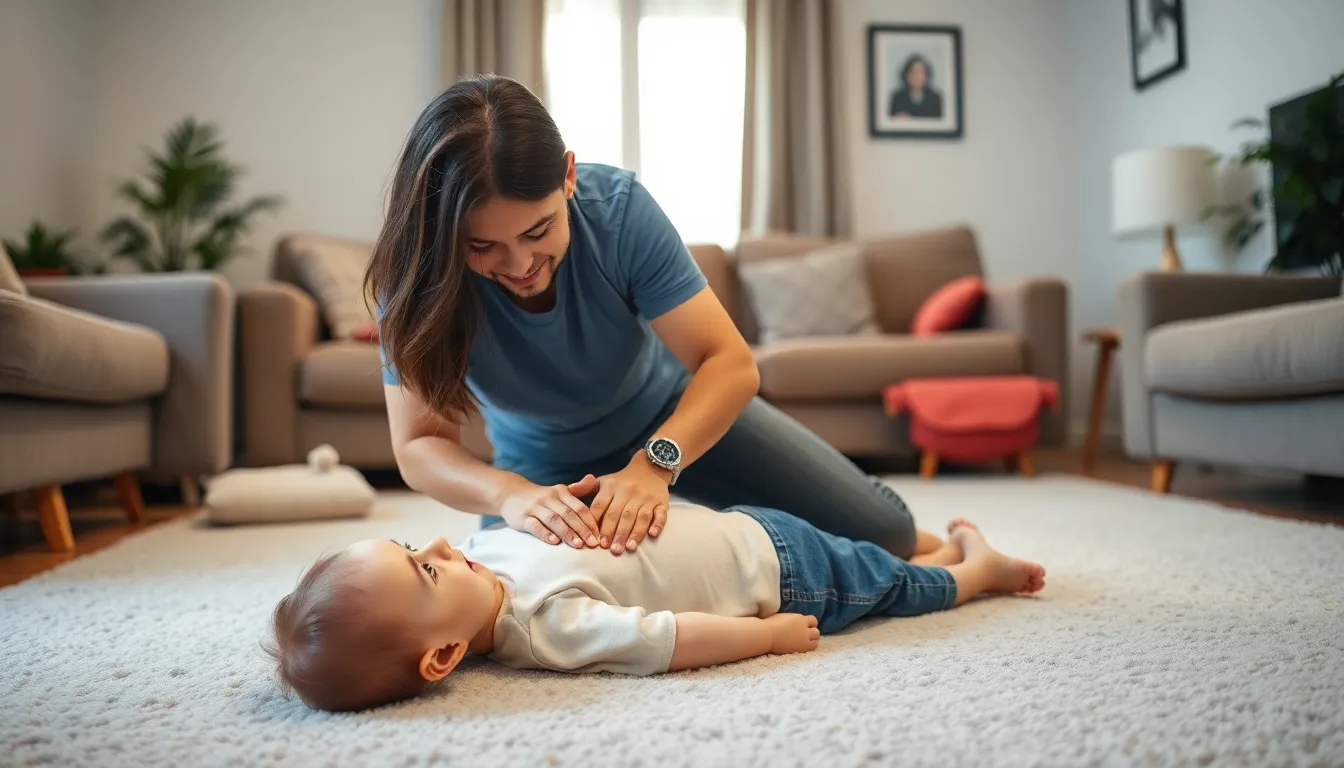When it comes to toddlers, every day can feel like an adventure—one minute they’re giggling at a silly face, and the next, they’re taking a tumble worthy of an Olympic gold medal in gymnastics. As adorable as they are, little ones have a knack for turning the most mundane activities into mini crises. That’s where toddler first aid comes in, your trusty sidekick in navigating the wild world of bumps, bruises, and the occasional snack-related choking hazard.
Table of Contents
ToggleUnderstanding Toddler First Aid
First aid for toddlers serves as an essential skill for parents and caregivers. Accidents can happen in an instant, making knowledge in this area crucial.
Importance of Toddler First Aid
Knowing toddler first aid equips caregivers to respond effectively in emergencies. Seventy-two percent of parents express concerns about their child’s safety, highlighting the need for preparedness. Immediate action can prevent minor injuries from escalating into serious issues. Understanding techniques like CPR and choking relief significantly enhances a caregiver’s confidence and ability to act quickly. Access to first aid resources can ensure toddlers receive prompt assistance in various situations.
Common Accidents and Injuries in Toddlers
Toddlers face a range of potential hazards every day. Common accidents include falls, which frequently lead to bruises or sprains. Choking on small objects remains a leading concern, with toys and foods posing major risks. Burns from hot liquids or surfaces can result in serious injuries. Cuts and scrapes occur during playtime, often requiring immediate attention. Insect bites and allergic reactions can develop unexpectedly, leading to discomfort or severe reactions. Recognizing these common injuries helps caregivers prepare for swift and effective response strategies.
Essential First Aid Techniques

Understanding essential first aid techniques for toddlers offers peace of mind for parents and caregivers. Being prepared for emergencies can make a significant difference in various situations.
CPR for Toddlers
CPR becomes critical during respiratory or cardiac emergencies. Begin by ensuring the environment is safe, then check if the toddler is responsive. For an unresponsive child, call emergency services immediately. Perform 30 chest compressions followed by two rescue breaths. Compressions should be given at a depth of about 1.5 inches and a rate of 100 to 120 per minute. Use only one hand for smaller toddlers. Watch for signs of responsiveness after a few cycles. Recovery requires immediate attention. Following these steps contributes to the child’s chances of survival.
Dealing with Choking
Recognizing choking signs in toddlers is vital for effective intervention. If a child cannot cough, cry, or breathe, immediate action is necessary. Stand behind the toddler and give five back blows using the heel of your hand. Follow this with five abdominal thrusts, also known as the Heimlich maneuver. Position your fists above the navel, thrust upward and inward. Continue alternating between back blows and abdominal thrusts until the object is expelled or medical help arrives. Awareness and prompt action can save lives during choking emergencies.
Home First Aid Kit for Toddlers
A well-stocked home first aid kit can make a significant difference when caring for toddlers. Parents and caregivers must ensure that essential items are always available for various minor injuries and emergencies.
Must-Have Items
Include adhesive bandages in various sizes to treat cuts and scrapes. Antiseptic wipes help clean wounds, minimizing infection risk. A digital thermometer keeps track of temperature, assisting in fever management. Non-aspirin pain relievers, such as acetaminophen or ibuprofen, provide relief from discomfort. Additionally, gauze pads, adhesive tape, and a pair of tweezers are vital for treating more significant injuries. For insect bites or allergic reactions, antihistamines, such as diphenhydramine, prove beneficial. Lastly, a CPR face shield allows for safe breathing assistance during emergencies.
How to Organize Your Kit
Start by selecting a durable, waterproof container for the kit. Clearly label sections within the container for easy access to essential items. Arrange bandages in one compartment, while antiseptics and ointments occupy another. Organize medicines according to type and dosage to prevent confusion during emergencies. Keep a detailed first aid manual within the kit for reference on administering care. Regularly check expiration dates of medications and replace as necessary to ensure everything remains usable. Create a list of items in the kit and update it whenever new supplies are added or removed.
When to Seek Professional Help
Parents and caregivers must know when to seek professional help for toddlers. Recognizing the signs of serious conditions can make a significant difference in outcomes.
Recognizing Serious Conditions
Signs that indicate the need for immediate professional help include difficulty breathing, high fever over 104°F, persistent vomiting, or seizures. Unresponsiveness or extreme lethargy often requires urgent medical attention too. Additionally, severe head injuries or excessive bleeding can pose serious risks. If a toddler shows signs of an allergic reaction, including swelling, hives, or difficulty swallowing, it’s vital to seek help without delay. Monitoring these symptoms allows caregivers to act quickly when a child faces a serious health threat.
Emergency Contact Information
Maintaining a list of emergency contacts is essential for swift action during a crisis. Keep local pediatrician details on hand, along with the nearest hospital’s number. In case of emergencies, know how to reach poison control at 1-800-222-1222. Including trusted family members or friends can provide additional support when needed. Store this information in an easily accessible place, like on the fridge or near the phone. Regularly update contact details ensures the information remains current and reliable.
Being equipped with toddler first aid knowledge is vital for every parent and caregiver. Accidents can happen quickly and understanding how to respond can make all the difference. By mastering essential techniques like CPR and choking relief parents can face emergencies with confidence.
Maintaining a well-stocked first aid kit tailored for toddlers ensures that help is always within reach. Recognizing when to seek professional medical assistance is equally important. With awareness and preparedness parents can protect their little ones from potential dangers and create a safer environment for exploration and play.




